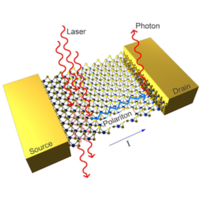Abstract
Mobile quantum impurities interacting with a fermionic bath form quasiparticles known as Fermi polarons. We demonstrate that a force applied to the bath particles can generate a drag force of similar magnitude acting on the impurities, realizing a novel, nonperturbative Coulomb drag effect. To prove this, we calculate the fully self-consistent, frequency-dependent transconductivity at zero temperature in the Baym-Kadanoff conserving approximation. We apply our theory to excitons and exciton polaritons interacting with a bath of charge carriers in a doped semiconductor embedded in a microcavity. In external electric and magnetic fields, the drag effect enables electrical control of excitons and may pave the way for the implementation of gauge fields for excitons and polaritons. Moreover, a reciprocal effect may facilitate optical manipulation of electron transport. Our findings establish transport measurements as a novel, powerful tool for probing the many-body physics of mobile quantum impurities.
- Received 23 March 2018
- Revised 12 June 2019
DOI:https://doi.org/10.1103/PhysRevX.9.041019
Published by the American Physical Society under the terms of the Creative Commons Attribution 4.0 International license. Further distribution of this work must maintain attribution to the author(s) and the published article’s title, journal citation, and DOI.
Published by the American Physical Society
Physics Subject Headings (PhySH)
Popular Summary
Polaritons are, in essence, modified photons. Unlike traditional photons, these part-light, part-matter composite quasiparticles can strongly interact with each other and with other matter particles while still retaining their photonic character. This unique ability allows for some novel applications and studies of fundamental physics. However, since polaritons are charge neutral, one would expect that the standard tools used to control and manipulate charged particles like electrons would not be applicable. Here, we theoretically show that polaritons immersed in an electron gas respond to external electric and magnetic fields much like charged particles.
Specifically, we show that the motion of the electron system leads to the emergence of an effective electric or magnetic field for polaritons, which, ideally, can be of the same order of magnitude as the external electric field. This effective field leads to a novel drag effect, allowing for manipulation of polaritons using external electric or magnetic fields.
The realization of effective magnetic and electric fields for photons can be used to realize behaviors such as quantized orbits in magnetic fields, which are typically reserved for charged particles. When combined with strong interactions, the effective fields would enable exotic many-body phenomena, such as the fractional quantum Hall effect of light.



